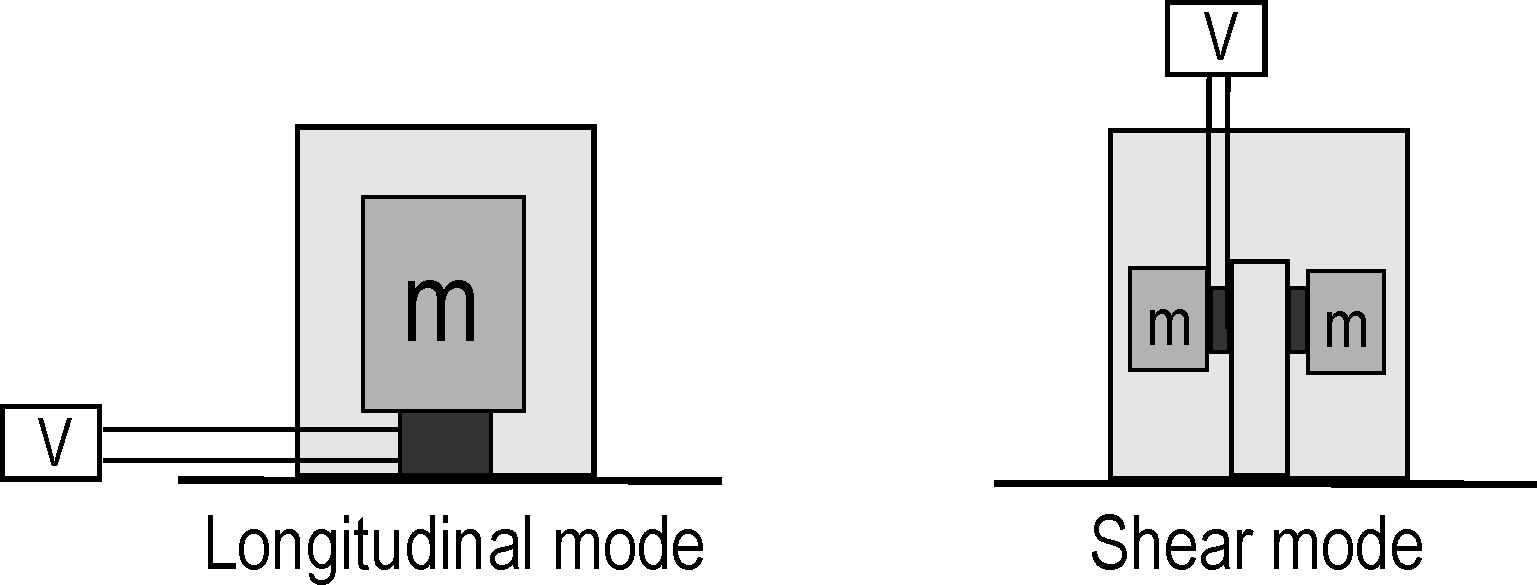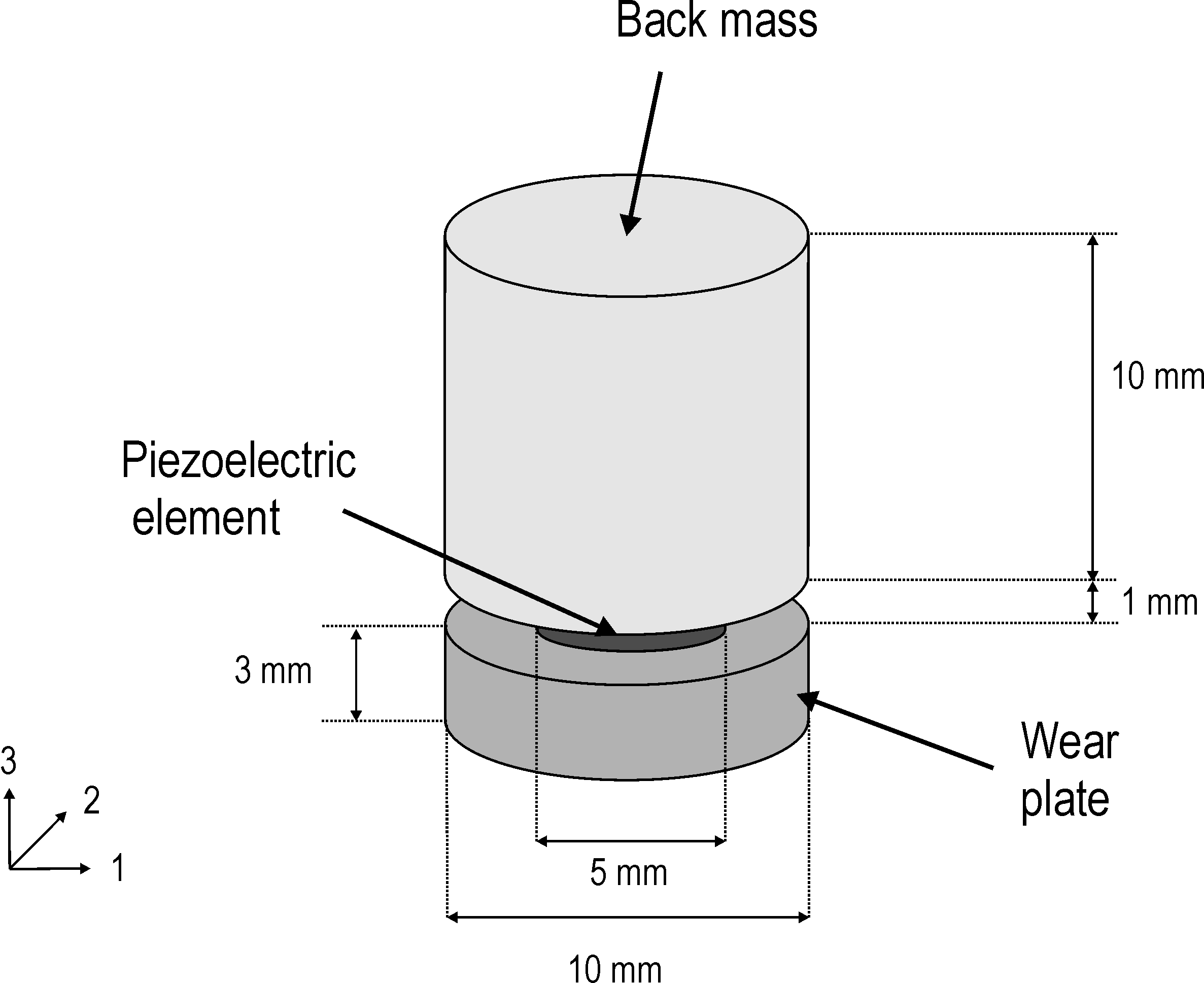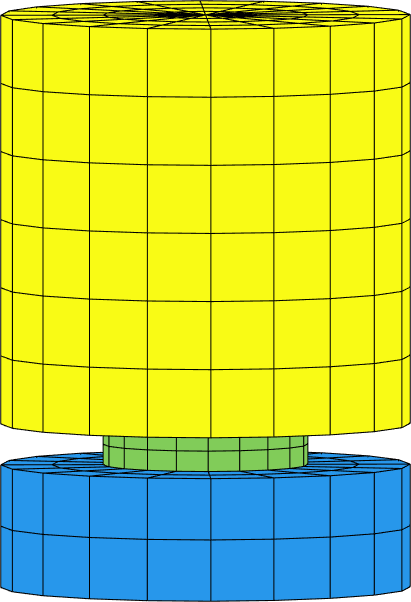
 PDF Index
PDF IndexSDT-piezo
Contents
Functions

 PDF Index
PDF Index |
This application example deals with the determination of the sensitivity of a piezoelectric sensor to base excitation.
By far the most common sensor for measuring vibrations is the accelerometer. The basic working principle of such a device is presented in Figure 8.1(a). It consists of a moving mass on a spring and dashpot, attached to a moving solid. The acceleration of the moving solid results in a differential movement x between the mass M and the solid. The governing equation is given by,
| (1) |
In the frequency domain x/x0 is given by,
| (2) |
with ωn = √k/M and ξ=b/2√kM and for frequencies ω << ωn, one has,
| (3) |
showing that at low frequencies compared to the natural frequency
of the mass-spring system, x is proportional to the acceleration
x0. Note that since the proportionality factor is
−1/ωn2, the sensitivity of the sensor is increased
as ωn2 is decreased. At the same time, the frequency band
in which the accelerometer response is proportional to
x0 is reduced.
(a) (b)
Figure 8.1: Working principle of an accelerometer
The relative displacement x can be measured in different ways
among which the use of piezoelectric material, either in longitudinal or shear mode (Figure 8.2).
In such configurations, the strain applied to the piezoelectric material is proportional to the relative displacement between the
mass and the base. If no amplifier is used, the voltage generated between the electrodes of the piezoelectric material is directly
proportional to the strain, and therefore to the relative displacement. For frequencies well below the natural frequency of
the accelerometer, the voltage produced is therefore proportional to the absolute acceleration of the base.

Figure 8.2: Different sensing principles for standard piezoelectric accelerometers
A basic design of a piezoelectric accelerometer working in the longitudinal mode is shown in Figure 8.3. In this example, the casing of the accelerometer is not taken into account, so that the device consists in a 3mm thick rigid wear plate (10mm diameter), a 1mm thick piezoelectric element (5mm diameter), and a 10mm thick (10mm diameter) steel proof mass. The mechanical properties of the three elements are given in Table 8.1. The piezoelectric properties of the sensing element are given in Table 8.2 and correspond to SONOX_P502_iso property in m_piezo Database. The sensing element is poled through the thickness and the two electrodes are on the top and bottom surfaces.

Figure 8.3: Basic design of a piezoelectric accelerometer working in the longitudinal mode
Property Value d31=d32 -185 10−12 pC/N (or m/V) d33 440 10−12 pC/N (or m/V) d15=d24 560 10−12 pC/N (or m/V) є33T=є22T=є11T 1850 є0 є0 8.854 10−12 Fm−1
Table 8.2: Piezoelectric properties of the sensing element
The sensitivity curve of the accelerometer, expressed in V/m/s2 is used to assess the response of the sensor to a base acceleration in the sensing direction (here vertical). In order to compute this sensitivity curve, one needs therefore to apply a uniform vertical base acceleration to the sensor and to compute the response of the sensing element as a function of the frequency.
The mesh is built and visualized in  d_piezo('TutoPzAccel-s1')
. It is shown in Figure 8.4
d_piezo('TutoPzAccel-s1')
. It is shown in Figure 8.4

Figure 8.4: Mesh of the piezoelectric accelerometer. The different colors represent the different groups
The call includes the meshing of the accelerometer, the definition of material properties, as well as the definition of electrodes.
In addition, the bottom electrode is grounded, and both a voltage and a charge sensor are defined for the top electrode.
In  d_piezo('TutoPzAccel-s2')
, a displacement sensor at the center of the base is defined in order to compute the sensitivity.
d_piezo('TutoPzAccel-s2')
, a displacement sensor at the center of the base is defined in order to compute the sensitivity.
%% Step 2 - Define sensors and actuators % -MatID 2 requests a charge resultant sensor % -vout requests a voltage sensor model=p_piezo('ElectrodeMPC Top sensor -matid 2 -vout',model,'z==0.004'); % -ground generates a v=0 FixDof case entry model=p_piezo('ElectrodeMPC Bottom sensor -ground',model,'z==0.003'); % Add a displacement sensor for the basis model=fe_case(model,'SensDof','Base-displ',1.03);
The sensitivity for the sensor used in a voltage mode is then computed using an imposed displacement on the basis. The measured displacement is transformed to acceleration in the frequency domain.
It is represented in Figure 8.5 and is computed with the following script:
( d_piezo('TutoAccel-s3')
)
d_piezo('TutoAccel-s3')
)
%% Step 3 - Response with imposed displacement % Remove the charge sensor (not needed) model=fe_case(model,'remove','Q-Top sensor'); % Link dofs of base and impose unit vertical displacement n1=feutil('getnode z==0',model); rb=feutilb('geomrb',n1,[0 0 0],fe_c(feutil('getdof',model),n1(:,1),'dof')); rb=fe_def('subdef',rb,3); % Keep vertical displacement model=fe_case(model,'DofSet','Base',rb); % Other parameters f=linspace(1e3,2e5,200)'; model=stack_set(model,'info','Freq',f); % freq. for computation % Reduced ss-model [sys,TR1]=fe2ss('free 5 10 0 -dterm',model,5e-3); % C1=qbode(sys,f(:)*2*pi,'struct-lab');C1.name='SS-voltage'; C1.X{2}={'Sensor output(V)';'Base Acc(m/s^2)';'Sensitivity (V/m/s^2)'}; %outputs % C1 compute accel and sensitivity C1.Y(:,2)=C1.Y(:,2).*(-(C1.X{1}*2*pi).^2); % Base acc C1.Y(:,3)=C1.Y(:,1)./C1.Y(:,2);% Sensitivity ci=iiplot; iicom(ci,'curveinit',{'curve',C1.name,C1}); iicom('ch3'); d_piezo('setstyle',ci)
.png)
Figure 8.5: Sensitivity of the accelerometer in the voltage mode, uniform acceleration imposed at the base
The sensor can also be used in the charge mode. The following scripts compares the sensitivity of the sensor used in the voltage and charge
modes. The sensitivities are normalized to the static sensitivity in order to be compared on the same graph, as the orders of magnitude are very different (Figure 8.6). The charge sensor corresponds to a short-circuit condition which results in a lower resonant frequency than the sensor used in a voltage mode where the electric field is present in section 6.3.4 for a plate. Here the difference of eigenfrequency is however higher (about 10%) due to the fact that there is more strain energy in the piezoelectric element, and that it is used in the d33 mode which has a higher electromechanical coupling factor than the d31 mode.
( d_piezo('TutoPzAccel-s4')
)
d_piezo('TutoPzAccel-s4')
)
%% Step 4 - Compare charge and voltage mode for sensing model=d_piezo('MeshBaseAccel'); model=fe_case(model,'remove','V-Top sensor'); % Short-circuit electrodes of accelerometer model=fe_case(model,'FixDof','V=0 on Top Sensor', ... p_piezo('electrodedof Top sensor',model)); % Other parameters model=stack_set(model,'info','Freq',f); % Link dofs of base and impose unit vertical displacement n1=feutil('getnode z==0',model); rb=feutilb('geomrb',n1,[0 0 0],fe_c(feutil('getdof',model),n1(:,1),'dof')); rb=fe_def('subdef',rb,3); % Keep vertical displacement model=fe_case(model,'DofSet','Base',rb); % Reduced model [sys2,TR1]=fe2ss('free 5 10 0 -dterm',model,5e-3); % C2=qbode(sys2,f(:)*2*pi,'struct');C2.name='SS-charge'; C2.X{2}={'Sensor output(V)';'Base Acc(m/s^2)';'Sensitivity (normalized)'}; %outputs C1.X{2}={'Sensor output(q)';'Base Acc(m/s^2)';'Sensitivity (normalized)'}; % C2 compute accel and sensitivity C2.Y(:,2)=C2.Y(:,2).*(-(C2.X{1}*2*pi).^2); % Base acc C2.Y(:,3)=C2.Y(:,1)./C2.Y(:,2);% Sensitivity % Normalize sensitivity to first freq C1.Y(:,3)=C1.Y(:,3)/abs(C1.Y(1,3)); C2.Y(:,3)=C2.Y(:,3)/abs(C2.Y(1,3)) ci=iiplot; iicom(ci,'curveinit',{'curve',C1.name,C1;'curve',C2.name,C2}); ... iicom('ch3'); d_piezo('setstyle',ci)
.png)
Figure 8.6: Comparison of the normalized sensitivities of the sensor used in the charge and voltage mode
Experimentally, the sensitivity curve can be measured by attaching the accelerometer to a shaker in order to excite the base. Usually, this is done with an electromagnetic shaker, but we illustrate in the following example the use of a piezoelectric shaker for sensor calibration. The piezoelectric shaker consists of two steel cylindrical parts with a piezoelectric disc inserted in between. The base of the shaker is fixed and the piezoelectric element is used as an actuator: imposing a voltage difference between the electrodes results in the motion of the top surface of the shaker to which the accelerometer is attached (Figure 8.7).

Figure 8.7: Piezoelectric accelerometer attached to a piezoelectric shaker for sensor calibration
The piezoelectric properties for the actuating element in the piezoelectric shaker are identical to the ones of the sensing element given in Table 4.3 and it is poled through the thickness.
In  d_piezo('TutoPzAccShaker-s1')
, the mesh is produced and visualized (Figure 8.8).
d_piezo('TutoPzAccShaker-s1')
, the mesh is produced and visualized (Figure 8.8).
Then in  d_piezo('TutoPzAccShaker-s2')
, a voltage actuator is defined for the piezoelectric disk in the piezoelectric shaker by setting the bottom electrode potential to zero,
and defining the top electrode potential as an input, and an acceleration sensor is defined at the base of the accelerometer.
d_piezo('TutoPzAccShaker-s2')
, a voltage actuator is defined for the piezoelectric disk in the piezoelectric shaker by setting the bottom electrode potential to zero,
and defining the top electrode potential as an input, and an acceleration sensor is defined at the base of the accelerometer.

Figure 8.8: Mesh of the piezoelectric accelerometer attached to a piezoelectric shaker
 d_piezo('TutoPzAccShaker-s3')
is used to compute the response on the sensors (acceleration at the base of the accelerometer, and voltage on the piezo disk in the accelerometer) and to deduce the sensitivity of the accelerometer by dividing the sensor output by the base acceleration.
d_piezo('TutoPzAccShaker-s3')
is used to compute the response on the sensors (acceleration at the base of the accelerometer, and voltage on the piezo disk in the accelerometer) and to deduce the sensitivity of the accelerometer by dividing the sensor output by the base acceleration.
%% Step 3 - Compute response, voltage input on shaker f=linspace(1e3,2e5,200)'; model=stack_set(model,'info','Freq',f); % Reduced ss-model model=fe_case(model,'pcond','Piezo','d_piezo(''Pcond'')'); [sys,TR1]=fe2ss('free 5 45 0 -dterm ',model,1e-3); % C1=qbode(sys,f(:)*2*pi,'struct-lab');C1.name='SS-voltage'; C1.X{2}={'Sensor output(V)';'Base Acc(m/s^2)';'Sensitivity (V/m/s^2)'}; %outputs % Compute sensitivity C1.Y(:,3)=C1.Y(:,1)./C1.Y(:,2);% Sensitivity ci=iiplot; iicom(ci,'curveinit',{'curve',C1.name,C1}); iicom('ch3'); d_piezo('setstyle',ci)
The sensitivity curve obtained is shown in Figure 8.9.
It is comparable to the one computed with imposed displacement around the natural frequency of the accelerometer, but at low frequencies, the flat
part is not correctly represented and a few spurious peaks appear at high frequencies. These differences are due to the fact that the piezoelectric
shaker does not impose a uniform acceleration of the base of the sensor, and has several resonance frequencies in the band of interest. There are also lateral (contraction) effects due to the piezoelectric element in the shaker which induce a response of the accelerometer and modify the sensitivity curve.
.png)
Figure 8.9: Sensitivity curve obtained with a piezoelectric shaker


